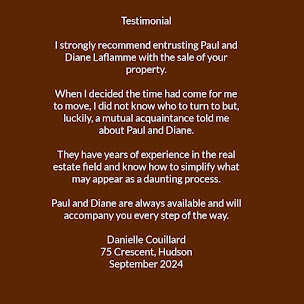Plans to limit residential sprawl in the greater Montreal area over the next two decades could threaten St. Lazare's city-within-a-forest identity, according to Pierre Kary, the town's mayor.
"Twenty years is a blink of an eye in terms of residential development," Kary said. "As mayor, it is my role to ensure that residents benefit from change rather than be negatively impacted.
"I cannot just allow development in St. Lazare to go unmanaged, or managed from Montreal or by developers" he added. "We want development, but we want development that is right for St. Lazare."
In May, the Communauté métropolitaine de Montréal, the umbrella planning organization for Montreal Island and its suburbs, presented a proposal - called the Plan métropolitain d'amenagement et de dévélopment (PMAD) - that would slow the march of housing subdivisions off the island.
St. Lazare, which has a population of just under 20,000, is part of the Montreal Metropolitan Community, which covers 82 municipalities with a total population of 3.7 million.
"Under the PMAD's plan for sustainable development, objectives are set out to better receive 530,000 people and 320,000 new homes within the MMC in the next 20 years," Kary said.
He said that in order to deal with that increase, minimum density levels are being set for each region.
For the region of Vaudreuil-Soulanges, which includes St. Lazare, the average density for new residential developments will be 16 housing units per hectare for 2011-2016; 18 housing units per hectare for 2017-2021; 20 housing units per hectare for 2022-2026 and 22 housing units per hectare for 2026-2031.
"This contrasts greatly with the housing density within our perimeter of about 3.4 housing units per hectare," Kary said.
Kary noted that the average density is measured over the whole MRC, which is comprised of 23 off-island communities, not just in St. Lazare.
However, he added, St. Lazare is one of the municipalities with the most available land for residential development with much of the 518 hectares available in 2006 still available for residential development.
"We are among those with the most land available," he said.
"With the PMAD, we become a municipality even more attractive for residential development ... and moreover for development at a much higher density than is typical for our community."
Kary said a jump from 3.4 residential units to 16 units per hectare would be "dramatic for St. Lazare," which has equestrian areas that are at a density of about one unit per hectare.
"We have an identity, a brand," he said. "Our brand is that of singlefamily homes on large lots with plenty of trees favourable to our equestrian community - a city within a forest.
"The PMAD, if not properly integrated into a new urban plan, can be a threat to our identity."
The mayor said planning is needed as 16 to 22 housing units per hectare is not possible in sectors that don't have the required infrastructures.
"Many undeveloped sectors will have to be on septic systems, like most of our territory," he said, noting that the town also has a number of wetlands that need to be protected since they are important for the water supply in the town, which is entirely dependent on underground wells.
Kary acknowledged, however, that change is coming, and even though St. Lazare is now the most youthful town in Quebec, with 30 per cent of its population under 30 years old, it must prepare for an increase in an elderly population over the next two decades.
"We are facing a new reality," he said.
"Although it is anticipated that the demographics are such that there will be an increase of 35-to 54-year-olds, the real demographic change will be the increase of 65-to 84-year-olds.
"Housing units for this demographic is scarce in St. Lazare," he said.
"With the required densification and change in demographics, we will have to find a way to protect our citywithin-a-forest brand while increasing the housing density and offering a diversity of housing options, including catering to the older demographic.
"This requires planning ... and is more than just protecting our brand or identity," said Kary, adding that all of the municipalities in the Vaudreuil-Soulanges MRC "will have to work closely to develop a regional plan for residential development."
A public consultation meeting for the southern part of the Montreal Metropolitan Community, which includes the Vaudreuil-Soulanges MRC, will take place Oct. 19 at the Exporail Le Musée férroviaire canadien, 110 St. Pierre St. in St. Constant.
© Copyright (c) The Montreal Gazette
Subscribe to:
Post Comments (Atom)







No comments:
Post a Comment